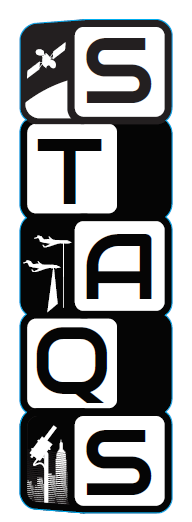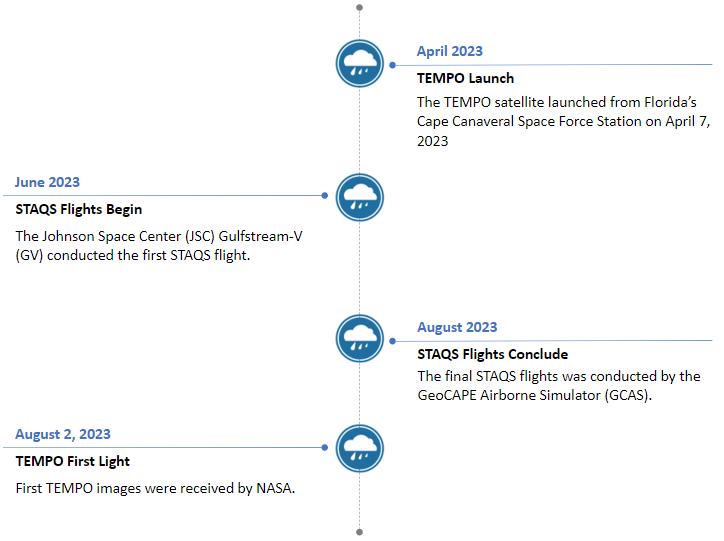Introduction to the Synergistic Tempo Air Quality Science (STAQS) Field Campaign
Introduction to the Synergistic Tempo Air Quality Science (STAQS) Field Campaign
NASA's Synergistic TEMPO Air Quality Science (STAQS) mission aimed to integrate satellite observations from the Tropospheric Emissions: Monitoring of Pollution (TEMPO) satellite with traditional air quality monitoring to improve understanding of air quality science and enhance societal benefits. STAQS was conducted during summer 2023, targeting urban areas, primarily Los Angeles, CA, New York City, NY, and Chicago, IL. One flight day was dedicated to Toronto, ON. Through multiple overpasses of these areas each day, STAQS aimed to map nitrogen dioxide (NO2), formaldehyde (HCHO), ozone (O3), aerosols, and greenhouse gasses (GHGs). This allowed changes in air quality to be sampled through the day, similar to TEMPO data products, but at a higher resolution. Two aircraft were outfitted with remote sensing payloads: the Johnson Space Center (JSC) Gulfstream-V (G-V) and the NASA Langley Research Center's (LaRC's) Gulfstream-III. Along with the two aircraft, STAQS also incorporated ground-based tropospheric ozone profiles from the NASA Tropospheric Ozone Lidar Network (TOLNet), measurements from Pandora spectrometers, and leveraged existing networks operated by the Environmental Protection Agency (EPA) and state air quality agencies.
During STAQS, collaborations with other ongoing air quality studies including the NOAA Atmospheric Emissions and Reactions Observed from Megacities to Marine Areas (AEROMMA) field campaign (in the same target areas as STAQS) and the NOAA Coastal Urban Plume Dynamics Study (CUPIDS) (Acdan et al., 2024, Judd et al., 2022) provided a synergistic observing system. STAQS primary goal was to improve the current understanding of air quality science using TEMPO observations.
TEMPO was launched on April 7, 2023, on a SpaceX Falcon 9 rocket from Florida's Cape Canaveral Space Force Station. TEMPO's goal is to monitor major air pollutants across North America every daylight hour at high special resolution at a geostationary orbit (GEO). The primary mission objectives of TEMPO involve understanding the dynamics of air qyality and pollution sources. The first images from the instrument were sent back on August 2, 2023 (click here to view the TEMPO gallery). TEMPO is a collaboration between the Smithsonian Astrophysical observatory and NASA, supported by the NASA Science Mission Directorate (SMD).
Note: The temporal coverage listed is for the entirety of the STAQS campaign and not an extensive list. The following is a more in depth breakdown of the important date ranges for STAQS:
- 05/10/23 - 11/17/23: Aircraft observations**
- 08/02/23 - Present: TEMPO observations
- 06/24/23 - 08/26/23: STAQS flights were conducted
**Data prior to the TEMPO launch were for air quality investigations.

Image Source:
NASA STAQS
Spatial Coverage:
United States
Temporal Coverage:
05/10/23 - 11/17/23
Scientific Objectives
- Evaluate TEMPO level 2 products geo-physically, spatially, and temporally.
- Interpret temporal and spatial evolution of air quality events tracked by TEMPO.
- Improve temporal estimates of anthropogenic, biogenic, and greenhouse gas emissions.
- Assess the benefit of assimilating TEMPO data into chemical transport models.
- Link air quality patterns to socio-demographic data.
Instruments Used
The following is a table of the platform type and platform, relevant instruments or locations, and study areas involved in the STAQS campaign.
| Platform Type | Platform | Relevant Instrument | Study Area |
|---|---|---|---|

|
Johnson Space Center Gulfstream-V |
GeoCAPE Airborne Simulator (GCAS) High Spectral Resolution Lidar-2 (HSRL-2) |
Nitrogen dioxide Formaldehyde Ozone Aerosols |

|
NASA Langley Research Center's (LaRC's) Gulfstream-III |
High-Altitude Lidar Observatory (HALO) Airborne Visible InfraRed Imaging Spectrometer - Next Generation (AVIRIS-NG) GeoCAPE Airborne Simulator (GCAS) |
Nitrogen dioxide Formaldehyde Ozone Aerosols |

|
Ground-based tropospheric ozone profiles |
City College of New York (CCNY) New York Tropospheric Ozone Lidar System (NYTOLS) Goddard Space Flight Center (GSFC) Tropospheric Ozone lidar (TROPOZ) Jet Propulsion Laboratory (JPL) Table Mountain Facility (TMF) Langley Research Center (LaRC) Langley Mobile Ozone Lidar (LMOL) NOAA Chemical Science Laboratory (CSL) Tunable Optical Profile for Aerosol and oZone lidar (TOPAZ) University of Alabama, Huntsville (UAH) Rocket-city O3 Quality Evaluation in the Troposphere lidar (RO3QET) Pandora spectrometers |
Vertical column ozone Trace gases Nitrogen dioxide Formaldehyde |

|
Ozonesondes |
El Paso, Texas Chiwaukee Prairie, Wisconsin San Antonio, Texas Austin, Texas Houston, Texas NASA GSFC |
Ozone profiles Atmosphere ozone |
Access Data
The ASDC archives and distributes all currently available publication-quality data for STAQS. Data from STAQS can be accessed on the ASDC STAQS landing page, the STAQS Sub-Orbital Order Tool (SOOT) page, and Earthdata Search. Data from TOLNet can be accessed at the TOLNet landing page.
Events of Interest
This section highlights events within the field campaign of particular scientific interest.

Relevant Publications
Acdan, J. J. M., Pierce B. R., Kuang S., McKinney T., Stevenson D., Newchurch M. J., Pfister G., Ma S., and Tong D. (2024). Evaluation of WRF-Chem air quality forecasts during the AEROMMA and STAQS 2023 field campaigns, Journal of the Air and Waste Management Associations. https://www.tandfonline.com/doi/full/10.1080/10962247.2024.2380333#abstract
Chouza, F., Leblanc, T., Wang, P., Brown, S. S., Zuraski, K., Chace, W., Womack, C. C., Peischl, J., Hair, J., Shingler, T., and Sullivan, J.: The Small Mobile Ozone Lidar (SMOL): instrument description and first results, Atmos. Meas. Tech. Discuss. [preprint], https://doi.org/10.5194/amt-2024-154, in review, 2024.
Judd L., Sullivan J., Crawford J., Lefer B., Yang Margin M., Travis K., Chance K., Liu X., Janz S., Hair J., Shingler T., Nehir A., Barton-Grimley R., Green R., Eastwood M., Hanisco T., McDonald B., Warneke C., Schwantes B., Mak J., Valin L., Demetillo A., and STAQS Team. (2022). Accelerating TEMPO Air Quality Science Through STAQS [Poster Presentation], AGU Fall Meeting 2022, Chicago, IL. https://ntrs.nasa.gov/api/citations/20220018296/downloads/STAQS_AGU_Poster_v3.pdf
Judd L. and Sullivan J. T. (2022). Synergistic TEMPO Air Quality Study (STAQS) [Presentation], AGES Workshop 2022, Boulder, CO. https://ntrs.nasa.gov/citations/20220014421